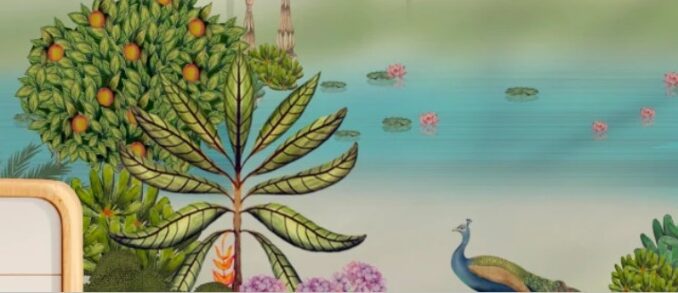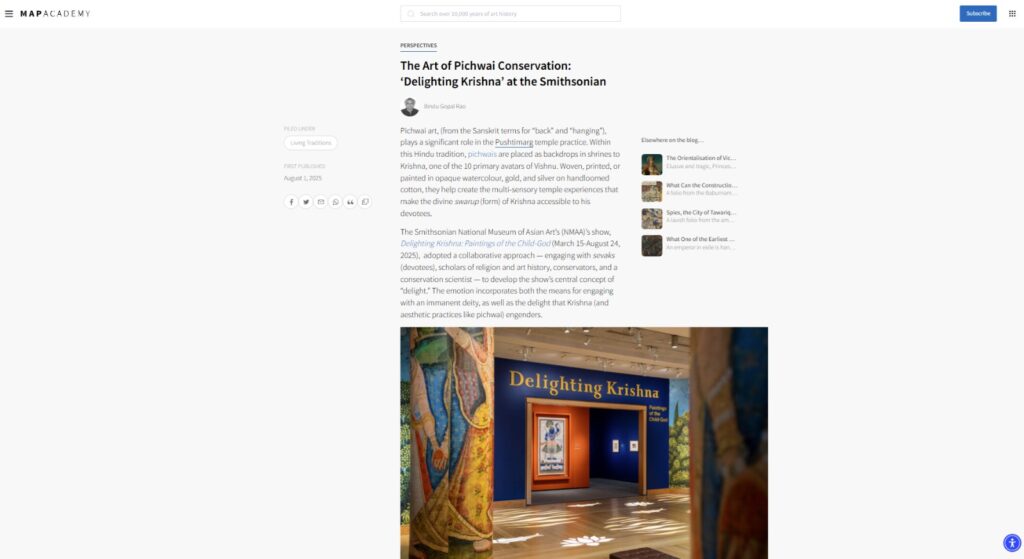
This exhibition is part of “The Arts of Devotion,” a five-year initiative at the National Museum of Asian Art funded by Lilly Endowment Inc. This initiative aims to further civil discourse around religion through the museum’s collections of Hindu and Buddhist art and arts of the Islamic world. Evidenced in Delighting Krishna, these religions are living traditions that have origins in the broad geographic area of Asia and are now global religions found in numerous countries, including the United States. “The Arts of Devotion” engages with communities from these religious traditions and with other key communities to help deepen the museum’s ability to tell stories about these artworks.
Reciprocity, respect, exchanges over time, and the kindness of the Vraj Cultural Center (Schuylkill Haven, Pennsylvania) were keys to the collaboration’s success. First, a team of ten museum staffers and fellows spent two days at Vraj, immersing ourselves in the philosophy and aesthetics of the Sampraday. Then their advisory committee spent two days at the museum meeting staff, viewing pichwai and brainstorming. The results were creative. Their design team, for example, translated the immersive quality of Pushtimarg devotionalism into the exhibition space through projected lights in the shapes of pichwai motifs, wall murals enlarged from telling details, and vibrant wall colours. They added flute music and a replica of a lalan (an adorned sculpture of baby Krishna) in response to community input.
The exhibition is reflective of NMAA’s commitment to collaboration with communities beyond the museum’s four walls. In Delighting Krishna, the team contextualizes their collection of pichwais through not only scientific and historic perspectives but also the personal perspectives of people who encounter works like these every day.
They have invited interested audiences to visit their digital interactive and a blog post on Pushtimarg in America on the museum’s website. Two additional blog posts on the scientific studies of pichwai are scheduled for early July and early August.
In March 2025, the museum hosted a free Community Day featuring a special haveli sangeet performance. Haveli sangeet refers to traditional devotional music sung daily in Pushtimarg temples to joyfully honor and celebrate Krishna. Attendees were also able to encounter pichwais through tours and insights from community members, curators, conservators, and a conservation scientist.
The National Museum of Asian Art is committed to preserving, exhibiting, researching, and interpreting art in ways that deepen our collective understanding of Asia and the world. Delighting Krishna aims to further civil discourse around religion through the museum’s collections. The visitor comment books are optional and anecdotal, but these comments are representative of the impact of the show.
- Fantastic art wonderfully curated! I love the different labels for community, conservator, and curator opinions—gives so much more insight to the context of it all and gave me a more intimate relationship to the art, culture, and of course to Krishna. Many thanks!
- Jai Shri Krishna! Very informative. One of a kind. I never thought I would see an exhibit honouring Indian culture, especially a niche part of Hinduism, in a Smithsonian. So cool!
- As a Hindu and Indian American myself, it felt very comforting and enlightening to not only see the art my family hangs up at home, but also learn the history and culture behind those art pieces. I learned more about my own culture, beliefs, and ideas.
Read the full story that first appeared in Map Academy here:


Leave a Reply